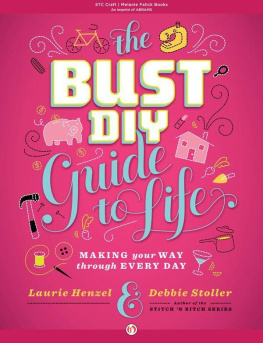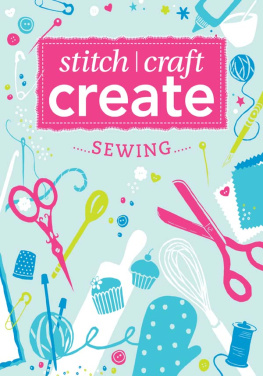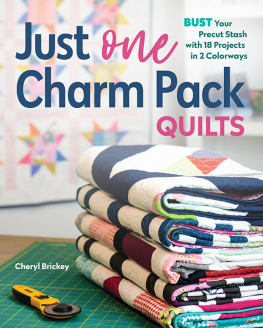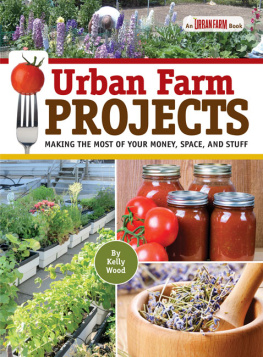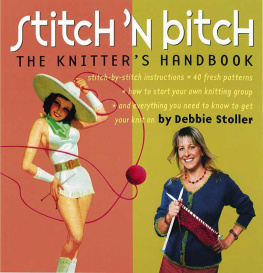

Contents






Introduction
When we first started BUST magazine back in 1993, we never would have predicted that some day wed be putting together a book about DIY. In fact, crafting wasnt on our minds at all back then. In those days, our main goal was to create a magazine that would be different than any other womens magazine on the newsstand. Instead of making our readers feel inadequate, we would celebrate themand ourselvesjust as we are. We would print the stories no other magazine would dare: about our confusion and at times ambivalence about relationships, careers, motherhood, and what our liveswe, the first generation of women to be raised on feminismwould or should be like. While other womens magazines ran stories about how to please your man, wed encourage our readers to learn how to please themselves; instead of schooling women on how to climb the corporate ladder, wed advise on how to fulfill oneself creatively; where other magazines told women how to lose weight, wed emphasize that all sizes are beautiful.
But maybe the fact that weve become so involved with DIY shouldnt come as such a surprise. After all, BUST itself was an entirely DIY endeavor. When we came up with the idea for the magazine, we were three girlsmyself, Laurie Henzel, and Marcelle Karpworking at low-level jobs at a childrens TV network. We didnt know anything about business plans, investors, profit margins, or other things that most entrepreneurs would consider when starting a new business venture. Thats because we considered BUST to be more of a cause than a commodity. This was long before blogs, so our only option for getting our voice out there was to create a printed magazine, and we set out in search of a way to get that first issue made without any money at all. We began by asking our writerly friends and colleagues if they had stories about their lives that they felt werent being told by the mainstream media, and if so, if they would like to contribute. Most of the people we approached were so excited about finally getting a forum where their voices could be heard that they were more than happy to oblige. Then we asked our graphic designer colleagues at the TV network if theyd be willing to help lay out the magazine during their off-hours. They too, were excited about the project, and got right to work, cutting and pasting the designs for each story by hand.
Within a few months we had our first issue, printed out on regular old copier paper, filled with first-person stories, artwork, fiction, and more. We stayed late at the office to surreptitiously make copies and got sore wrists from stapling them all together. But finally, there they were: 500 copies of our little magazine, or zine, as this kind of homemade publication is called. Back in the early 90s, thanks to the newly accessible desktop publishing tools, there were so many of these zines that there were entire stores devoted to them, and independent bookstores and record stores usually had a few shelves reserved for their display. We sent BUST out to all these places, asking them to sell the mag for us, and it quickly sold out. We had to create another 500 copiesonce again, late at night at our day-job officeto meet the demand. Soon we even began to receive fan mailletters from folks who told us how much they enjoyed the magazine, how much it meant to them, how it made them feel so much less alone.
That bit of encouragement was all we needed to keep going. We started working on a second issue, and pooled our money together to get it printed. And then a third issue. And with each new issue, we improved the magazine just a little bit. We went from photocopies to newsprint, and then eventually from newsprint to glossy paper. We didnt give up our day jobs, but BUST kept us excited and fulfilled as we grew our circulation bit by bit. In 2000, we partnered with a dot-com company that gave us a budget and some office space, and allowed us to finally quit our day jobs and work on BUST full-time. But when the dot-com bubble burst one short year later, so did our partnership. It was tough to lose our backing, but we pulled ourselves up by our bra straps. At this point there were just two of us running the magmyself on the editorial side of things and Laurie heading up design. We set up shop at Lauries house and started the magazine again, and thats how weve carried on for the past ten years (although we now have an actual office and a full-fledged staff). Today, BUST continues to be a completely woman-owned, woman-run independent operation, with no owners or investors to tell us what we can and cant publish. And how did we get here? Yup; we did it ourselves.
In the early years of the magazine our stories were mostly first-person narratives (our contributors were so anxious to get these untold womens stories out there), but as we grew, and our audience grew, we began publishing more reported stories, more interviews with women we admired (Bjrk, Tina Fey, Amy Sedaris, Amy Poehler, Yoko Ono, Gloria Steinem, Missy Elliott, Kathleen Hanna, Kim Gordon, Chlo Sevigny, Miranda July, Rosario Dawsonto name but a few), and more service-type piecesadvice columns and so on. Then, in 1997, we introduced a new crafting column, Shes Crafty, in which we planned to start publishing all kinds of DIY ideas. At that time, no one could imagine a magazine aimed at young women that would encourage such old-fashioned activities as soap-making, knitting your own clothes, or learning to make dinner from scratch. And in particular, what would a magazine that considered itself feminist be doing publishing such things? Cooking? Crocheting? These were exactly the types of things our feminist mothers had tried so hard to free us from; why would we voluntarily decide to go back?
But for us, there were plenty of reasons to promote DIY in our magazine, and the first and foremost of these was directly tied to our feminist roots. After all, for centuries, women had been entrusted with creating everything they needed to keep a family clothed, cleaned, and fed. They had to know how to make soap; they had to be able to weave fabric and sew or knit clothing for their family; they had to be able to create nutritious meals and preserve a harvest so that the family wouldnt go hungry in the middle of winter. These skills were necessary for survival, and women must have taken just as much pride in their ability to carry them out as men did in their ability to build a home or hunt a wild boar. But eventually, as soap, clothing, and even fully prepared frozen meals became available for purchase, knowing how to create these things became less and less important. To the womens movement of the 60s and 70s, achieving freedom from these tedious chores was the path to salvation. Up until then, women had been given the short end of the broomstick, they argued, stuck at home with the cleaning, cooking, and sewing, while the real actionand only chance at financial independencewas outside, in the work world, an arena that men had tried so hard to keep women out of for so long. Convinced that women had so much more to contribute to the world than kids and casseroles, feminists fought their way out of their homes and slammed the door behind them, hoping that they, and their daughters, would never find themselves trapped there again.
Next page
